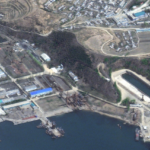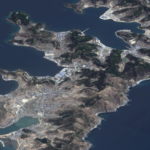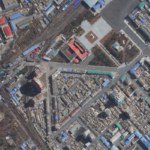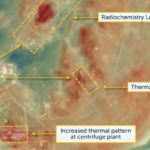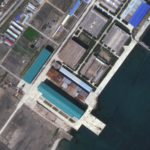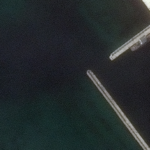July 15, 2021, by Joseph S. Bermudez Jr. and Victor Cha—
The Sinpo Shipyard is the counterpart to the Sinpo South Shipyard and focuses primarily on the production, maintenance, and repair of small fishing vessels. To a lesser degree, it has also been involved in the production, maintenance, and repair of small Korean Peoples’ Navy combatants. Since about 2009, the graving dock at the shipyard – one of the largest in North Korea – has played a crucial role in maintaining the operational status, repair, maintenance, and scrapping of the nation’s submarine force.
July 7, 2021, by Joseph S. Bermudez Jr. and Victor Cha—
The Mayang-do Navy Shipyard and submarine bases are the largest facilities of their kind in North Korea. Using unique off-nadir imagery collection, this report provides a close-up focus of these facilities, including views of the ROMEO class and SANGO class submarines, and Kim Jong-un’s yacht.
June 24, 2021, by Joseph S. Bermudez Jr. and Victor Cha—
Recent satellite imagery provides details into major maintenance and expansion at the Sunchon Airbase, which houses some of North Korea’s most modern and capable military aircraft in the Korean Air and Air Defense Force (KPAF)’s inventory. .. This post was updated on July 15, 2022. Recent satellite imagery provides details into major…
June 17, 2021, by Joseph S. Bermudez Jr. and Victor Cha—
Using unique off-nadir imagery collection, this report provides a close-up focus of the test launch sites, ports, and related facilities at Sinpo South Shipyard. This is the first of several Sharp Focus reports providing a unique view of the Sinpo South Shipyard, Sinpo area, and Mayang-do navy facilities using a remarkable high off-nadir (HON) image collected by Maxar Technologies during April 2021.
May 6, 2021, by Joseph S. Bermudez Jr., Victor Cha and Jennifer Jun—
Satellite imagery supports open-source reporting that the North Korea-China border has likely been closed to trade since January 2020 due to the North Korean government’s precautions against the transmission of the Covid-19 virus. However, a recent increase in the volume of rail cars in the Dandong and Sinuiju Customs areas, as well as the removal of protective coverings at the Sinuiju rail terminal and freight yard (between March 31 and April 1), suggest preparations to resume exports to China that would provide North Korea with some hard currency.
April 20, 2021, by Joseph S. Bermudez Jr. and Victor Cha—
Satellite imagery on April 19 shows that North Korea has positioned a cylindrical object on the submersible missile test barge at Nampo.
This object could be a launch tube for an SLBM, but this cannot be confirmed yet based on available imagery... Satellite imagery on April 19 shows that North Korea has positioned a cylindrical object on…
April 15, 2021, by Joseph S. Bermudez Jr., Victor Cha, Andy Dinville and Dana Kim—
Recently acquired LANDSAT 7 and 8 thermal infrared imagery of the Yongbyon Nuclear Research Center provide strong indications that during March and April 2021, activity involving the heating of buildings and operations of facility support systems had resumed at several locations.
These indications reveal clear patterns, distinct from the surrounding terrain and daily solar heating patterns, that suggest that the Radiochemistry Laboratory, its associated thermal plant, and the centrifuge plant resumed operations during the early part of March 2021 and have continued into mid-April 2021.
April 14, 2021, by Joseph S. Bermudez Jr. and Victor Cha—
The recent repositioning of the submersible missile test stand barge and floating dry-dock were not isolated events, but components of a series of small naval movements at the shipyard during the past four weeks.
These activities have both practical and conspicuously political motivations as North Korea prepares to launch its new ballistic missile submarine (SSB) and Kim Jong-un apparently undertakes a policy of gradually increasing provocative military actions.
April 8, 2021, by Joseph S. Bermudez Jr. and Victor Cha—
The recent repositioning of the submersible missile test stand barge was not an isolated event, but the latest in a series of small naval movements at the shipyard during the past several weeks. Satellite imagery of the Sinpo South Shipyard and its environs acquired on April 6 and 7, 2021 shows not only the recent movement of the submersible missile test stand barge, but also provides a general status update of the facility.
April 6, 2021, by Joseph S. Bermudez Jr., Victor Cha and Jennifer Jun—
A Maxar Technologies satellite image collected at 11:09 AM KST on April 6 shows that North Korea is moving its submersible missile test barge located at the Sinpo South Shipyard. As no missile canister is visible onboard the submersible missile test barge, this movement does not indicate an imminent SLBM test.
